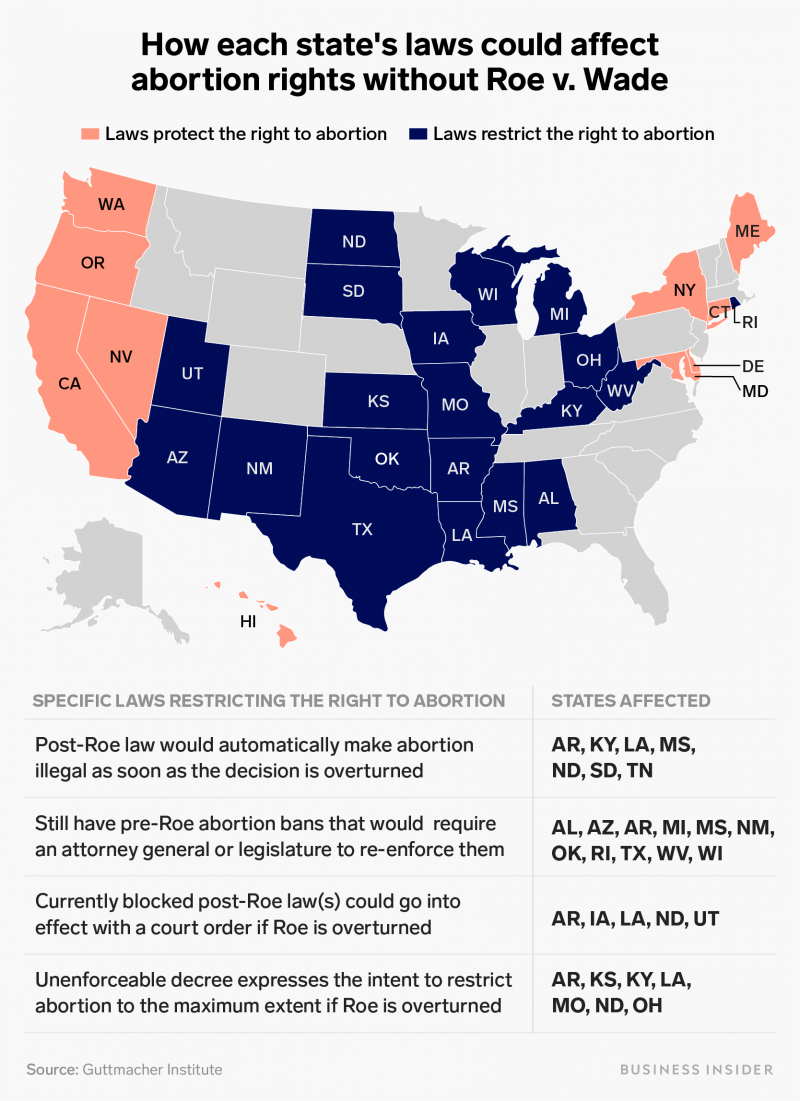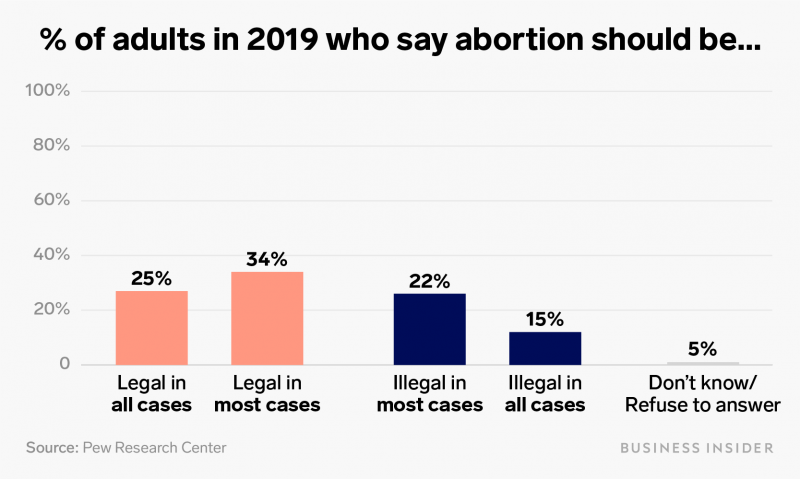- If the US Supreme Court overturns Roe v. Wade, which granted Americans a constitutional right to abortion in 1973, each state would again be able to decide whether their residents are legally allowed to have abortions.
- While 10 states currently have laws on the books that would keep abortion legal within their borders, 18 states have laws that could make the procedure illegal if Roe falls.
- In the decades since Roe, states have also passed laws that have chipped away at abortion access in the US.
- Many restrictions have made women’s’ ability to get an abortion increasingly dependent on where they live or whether they have the means to travel hundreds of miles to the nearest location.
- Visit Business Insider’s homepage for more stories.
The landmark Supreme Court case Roe v. Wade and subsequent rulings upholding it have granted the right to abortion for Americans since 1973 – but the reality of that right varies dramatically from state to state.
Since Roe became the law of the land, individual state legislatures have enacted dozens of restrictions and regulations to make it as difficult as possible for patients to actually access abortion.
From strict regulations on clinics and bans on abortion after a certain number of weeks, to requiring patients to receive counseling and undergo waiting periods, these laws have tested the limits of Roe – with many ending up in federal court.
The US Senate has confirmed two of President Donald Trump's Supreme Court nominees to give the Court a solidly conservative majority, causing many abortion-rights advocates to fear that such a makeup could result in Roe being overturned altogether.
The more likely scenario, according to legal experts, is for the high court to chip away at abortion rights by ruling in favor of the state-level restrictions that reach their docket - depending on which cases they actually decide to hear.
These seven charts and maps illustrate what abortion access in America actually looks like today, and what could happen if Roe fell.
The latest stage of pregnancy at which a patient can obtain an abortion in every US state, 2019

In the months of April and May alone, the governors of Ohio, Georgia, and Alabama signed some of the most restrictive abortion bans in the country.
While Ohio and Georgia's laws ban abortion after a fetal heartbeat can be detected around 5-6 weeks of pregnancy, Alabama outlaws the procedure altogether, and would charge doctors who perform abortions with a class A felony.
But none of these new laws or any previous six-week bans that states have passed have formally gone into effect, and the latest abortion bans are all being challenged in court.
This map shows the latest point in pregnancy a patient can currently obtain an abortion in each state, according to data from the Guttmacher Institute.
State laws that would explicitly outlaw or allow abortion if Roe v. Wade falls

If the Supreme Court does overturn Roe, the issue of abortion will go back to the states. Elizabeth Nash, a senior state issues manager at the Guttmacher Institute, explained all the possible outcomes to Insider.
Seven states passed "trigger laws" after Roe was decided, which would automatically make abortion illegal as soon as the decision is overturned.
But nine states have pre-Roe abortion bans or restrictions still on their books that are currently un-enforceable because they violate Roe.
Unlike trigger laws, Nash explained, these bans wouldn't go back into effect immediately. A government actor like an attorney general or a legislature would have to put them back in place.
Seven states have passed decrees that are "without the force of law" expressing their intent to limit abortion to the greatest extent permitted by federal law if Roe falls, Nash said.
On the flipside, 10 states have laws on the books that ensure abortion stays legal within their borders.
Abortion clinics per state, percent change from 2014 to 2017

In the decades since Roe, individual states have enacted a slew of restrictions to make it as difficult as possible for abortion clinics to operate, such that several states only have one remaining clinic.
Targeted Restrictions on Abortion Providers, or TRAP laws, impose very specific regulations on clinics. Oftentimes, these restrictions are so expensive that the costs of implementing them cause many clinics to close down altogether.
These include requirements on the width of corridors, the size and equipment of procedure rooms, and mandating that clinics have admission privileges at local hospitals, even though less than 0.5% of abortions result in complications.
Between 2014 and 2017, more clinics opened up in the Northeast and on the West Coast but shut down in the South and Midwest, which lost 9% and 6% of their clinics respectively, partly due to TRAP laws in some cases.
In 2017, 89% of US counties had no known abortion providers, with 38% of US women ages 15-44 living in those counties.

The Supreme Court struck down one of the most extreme TRAP laws, Texas' HB2, in a 5-3 vote in 2016. But despite that, over 20 states still have such laws on their books.
A closer look at the county level shows stark disparities in abortion access across the country. There are now 16 states where 95% of counties do not have an abortion clinic.
By causing clinics to close down, TRAP laws have the consequence of making patients further and further to get to a clinic, especially in states that require patients to make multiple trips to the clinic and undergo a 24-to-72 hour "waiting periods."
According to another new study from the Guttmacher Institute, patients travel an average of 34 miles each way to access abortion, and one in five American women have to travel at least 50 miles to reach their closest abortion provider.
How the phases of pregnancy and fetal development line up with abortion bans

In the past several years, states have made many attempts to restrict patients from getting abortions after a certain number of weeks - oftentimes before a woman even knows she's pregnant.
In 2019 alone, the Governors of Arkansas, Alabama, Georgia, Mississippi, Louisiana, Kentucky, Ohio, and Missouri signed bills to either severely restrict abortion with so-called "heartbeat bills" or, in Alabama's case, ban the procedure altogether.
Other states have tried to ban dilation & evacuation (D&E), the method commonly used to perform abortions after 14 weeks.
The surgical procedure is usually used in late-term miscarriages and abortions to remove the fetal tissue as safely as possible, and accounts for less than 0.5% of all abortions.
Prohibiting D&E abortions is effectively a ban on all second-trimester abortions, landing such bans in murky legal territory. In July, a judge in Oklahoma upheld the state's ban on D&E abortions.
Percent of adults in 2019 who say abortion should be legal or illegal

While the last decade has seen a huge increase in state-level abortion restrictions, Americans as a whole haven't become more anti-abortion in the past 20 years, according to survey data from Pew Research Center.
Currently, 59% of adults say abortion should be legal in all or most cases, while 37% say it should be illegal in all or most cases. Those numbers are almost exactly the same as they were back in 1995.
Percentage of Americans who think abortion should be legal or illegal broken down by political party and ideology

Abortion has long been a hot-button partisan issue, with support for abortion in all or most cases being highest among liberal Democrats and lowest among conservative Republicans.
But over a quarter of those who identify as conservative Republicans now believe abortion should be legal in all or most cases, according to Pew Research.
And while state legislatures are passing draconian abortion bans for the purpose of engaging in litigation they hope will overturn Roe v. Wade, bipartisan support for the landmark decision is at a new high.
2019 polling data from the Pew Research Center found that 70% of all Americans, including 50% of Republicans, believe Roe v. Wade should remain the law of the land.










